Comparison of Performance and Economic Efficiency for Greenhouse Solar versus Hot Air Drying: A Case of Crispy Mango Production
Abstract
1. Introduction
2. Materials and Methods
2.1. Material and Sample Preparation
2.2. Experimental Study
2.3. Drying Rate of Mango Slices
2.4. Color Measurement of Mango Slices
2.5. Total Phenolics and Antioxidant Analysis
2.5.1. Sample Extraction
2.5.2. Total Phenolic Content
2.5.3. DPPH and DPPH Radical Scavenging Activity
2.5.4. Ferric Reducing Antioxidant Power (FRAP) Assay
2.6. Sensory Evaluation of Mango Slices
2.7. Economic Analysis of the Dryer
2.8. Statistical Analysis
3. Results and Discussion
3.1. Drying Curves and Drying Rate
3.2. Color Parameters
3.3. Sensory Evaluation
3.4. Economic Analysis of the Dryers
3.5. Improving the Quality and Profitability of Crispy Mango Production for a Small-Scale Entrepreneur Using a Combination Hot Air and Greenhouse Solar Dryers
4. Conclusions
Author Contributions
Funding
Institutional Review Board Statement
Informed Consent Statement
Acknowledgments
Conflicts of Interest
References
- Yasunaga, E.; Fukuda, S.; Takata, D.; Spreer, W.; Sardsud, V.; Nakano, K. Quality changes in fresh mango fruits (Mangifera indica L. ’Nam Dok Mai’) under actual distribution temperature profile from Thailand to Japan. Environ. Control Biol. 2018, 56, 45–49. [Google Scholar] [CrossRef]
- Office of Agriculture Economics (OAE). Foreign Agricultural Trade Statistics of Thailand in 2020. Available online: http://impexp.oae.go.th/service/export.php (accessed on 11 June 2021).
- Matulaprungsan, B.; Wongs-Aree, C.; Penchaiya, P.; Boonyaritthongchai, P.; Srisurapanon, V.; Kanlayanarat, S. Analysis of critical control points of post-harvest diseases in the material flow of Nam Dok Mai mango exported to Japan. Agriculture 2019, 9, 200. [Google Scholar] [CrossRef]
- Pott, I.; Konard, S.; Scherer, R.; Wiriyacharee, P.; Mühlbauer, W. Quality of five Thai mango cultivars (Mangifera indica L.) using a solar drying system. CMU J. 2004, 3, 189–198. [Google Scholar]
- Janjai, S. A greenhouse type solar dryer for small-scale dried food industries: Development and dissemination. Int. J. Energy Environ. Eng. 2012, 3, 383–398. [Google Scholar]
- Guarte, R.C.; Pott, I.; Mühlbauer, W. Influence of drying parameters on β-carotene retention on mango leather. Fruits 2005, 60, 255–265. [Google Scholar] [CrossRef][Green Version]
- Chaudhari, R.H.; Gora, A.; Modi, V.M.; Chaudhari, H. Economic analysis of hybrid solar dryer for ginger drying. Int. J. Curr. Microbiol. App. Sci. 2018, 7, 2725–2731. [Google Scholar] [CrossRef]
- Poonia, S.; Singh, A.K.; Santra, P.; Jain, D. Economic analysis of inclined solar dryer for drying of fruit and vegetables. Int. J. Agric. Sci. 2019, 11, 9154–9159. [Google Scholar]
- Krungkaew, S.; Kingphadung, K.; Kwonpongsagoon, S.; Mahayothee, B. Costs and benefits of using parabolic greenhouse solar dryers for dried herb products in Thailand. Int. J. GEOMATE 2020, 18, 96–101. [Google Scholar] [CrossRef]
- Boonyasri, M.; Lertsatitthanakorn, C.; Wiset, L.; Poomsa-ad, N. Performance analysis and economic evaluation of a greenhouse dryer for pork drying. KKU Eng. J. 2011, 38, 433–442. [Google Scholar]
- Kondareddy, R.; Sivakumaran, N.; Radha Krishnan, K.; Nayak, P.K.; Sahu, F.M.; Singha, S. Performance evaluation and economic analysis of modified solar dryer with thermal energy storage for drying of blood fruit (Haematocarpus validus). J. Food Process. Preserv. 2021, 45, e15653. [Google Scholar] [CrossRef]
- ELkhadraoui, A.; Kooli, S.; Farhat, A. Study on effective of mixed mode solar greenhouse dryer for drying of red pepper. Int. J. Sci. Res. Eng. Technol. 2015, 3, 143–146. [Google Scholar]
- Mahayothee, B.; Thamsala, T.; Khuwijitjaru, P.; Janjai, S. Effect of drying temperature and drying method on drying rate and bioactive compounds in cassumunar ginger (Zingiber montanum). J. Appl. Res. Med. Aromat. Plants 2020, 18, 100262. [Google Scholar] [CrossRef]
- Singleton, V.L.; Rossi, J.A. Colorimetry of total phenolics with phosphomolybdic phosphotungstic acid reagents. Am. J. Enol. Vitic. 1965, 16, 144–158. [Google Scholar]
- Hossain, M.A.; Dey, P.; Joy, R.I. Effect of osmotic pretreatment and drying temperature on drying kinetics, antioxidant activity, and overall quality of taikor (Garcinia pedunculata Roxb.) slices. Saudi J. Biol. Sci. 2021, 28, 7269–7280. [Google Scholar] [CrossRef]
- Siddiq, M.; Sogi, D.S.; Dolan, K.D. Antioxidant properties, total phenolics, and quality of fresh-cut ’Tommy Atkins’ mangoes as affected by different pre-treatments. LWT-Food Sci. Technol. 2013, 53, 156–162. [Google Scholar] [CrossRef]
- Vongsak, B.; Kongkiatpaiboon, S.; Jaisamut, S.; Konsap, K. Comparison of active constituents, antioxidant capacity, and α-glucosidase inhibition in Pluchea indica leaf extracts at different maturity stages. Food Biosci. 2018, 25, 68–73. [Google Scholar] [CrossRef]
- Kiburi, F.G.; Kanali, C.L.; Kituu, G.M.; Ajwang, P.O.; Ronoh, E.K. Performance evaluation and economic feasibility of a solar-biomass hybrid greenhouse dryer for drying banana slices. Renew. Energy Focus 2020, 34, 60–68. [Google Scholar] [CrossRef]
- Blank, L.; Tarquin, A. Engineering Economy, 7th ed.; McGraw-Hill: New York, NY, USA, 2012; pp. 278–300. [Google Scholar]
- Fratianni, A.; Adiletta, G.; Di Matteo, M.; Panfili, G.; Niro, S.; Gentile, C.; Farina, V.; Cinquanta, L.; Corona, O. Evolution of carotenoid content, antioxidant activity and volatiles compounds in dried mango fruits (Mangifera indica L.). Foods 2020, 9, 1424. [Google Scholar] [CrossRef] [PubMed]
- Rumainum, I.M.; Worarad, K.; Srilaong, V.; Yamane, K. Fruit quality and antioxidant capacity of six Thai mango cultivars. Agric. Nat. Resour. 2018, 52, 208–214. [Google Scholar] [CrossRef]
- Önal, B.; Adiletta, G.; Crescitelli, A.; Di Matteo, M.; Russo, P. Optimization of hot air drying temperature combined with pre-treatment to improve physico-chemical and nutritional quality of ’Annurca’ apple. Food Bioprod. Process. 2019, 115, 87–99. [Google Scholar] [CrossRef]
- AlFarsi, M.; Alasalvar, C.; Morris, A.; Baron, M.; Shahidi, F. Compositional and sensory characteristics of three native sun-dried date (Phoenix Dactylifera L.) varieties grown in Oman. Agric. Food Chem. 2005, 53, 7586–7591. [Google Scholar] [CrossRef] [PubMed]
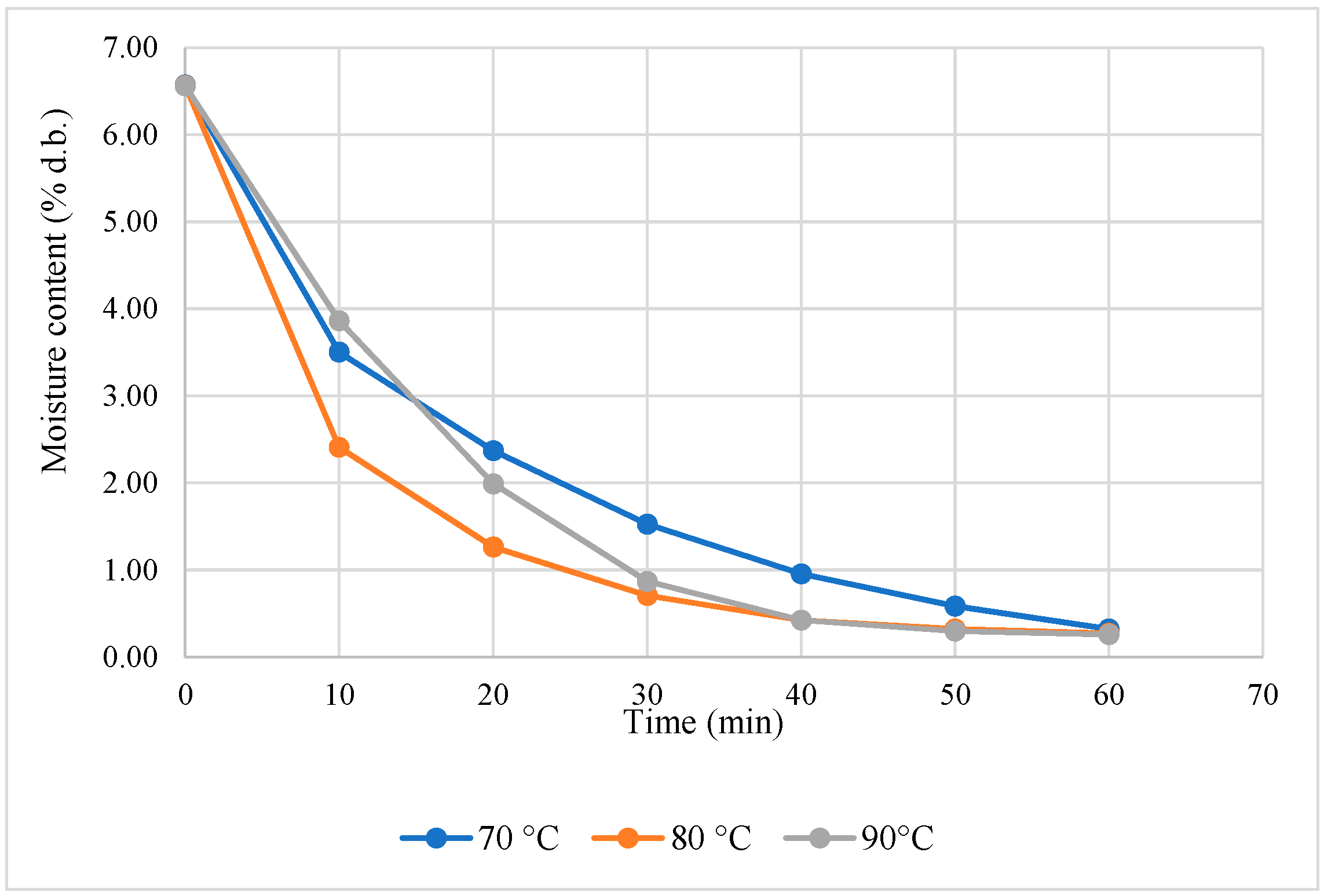

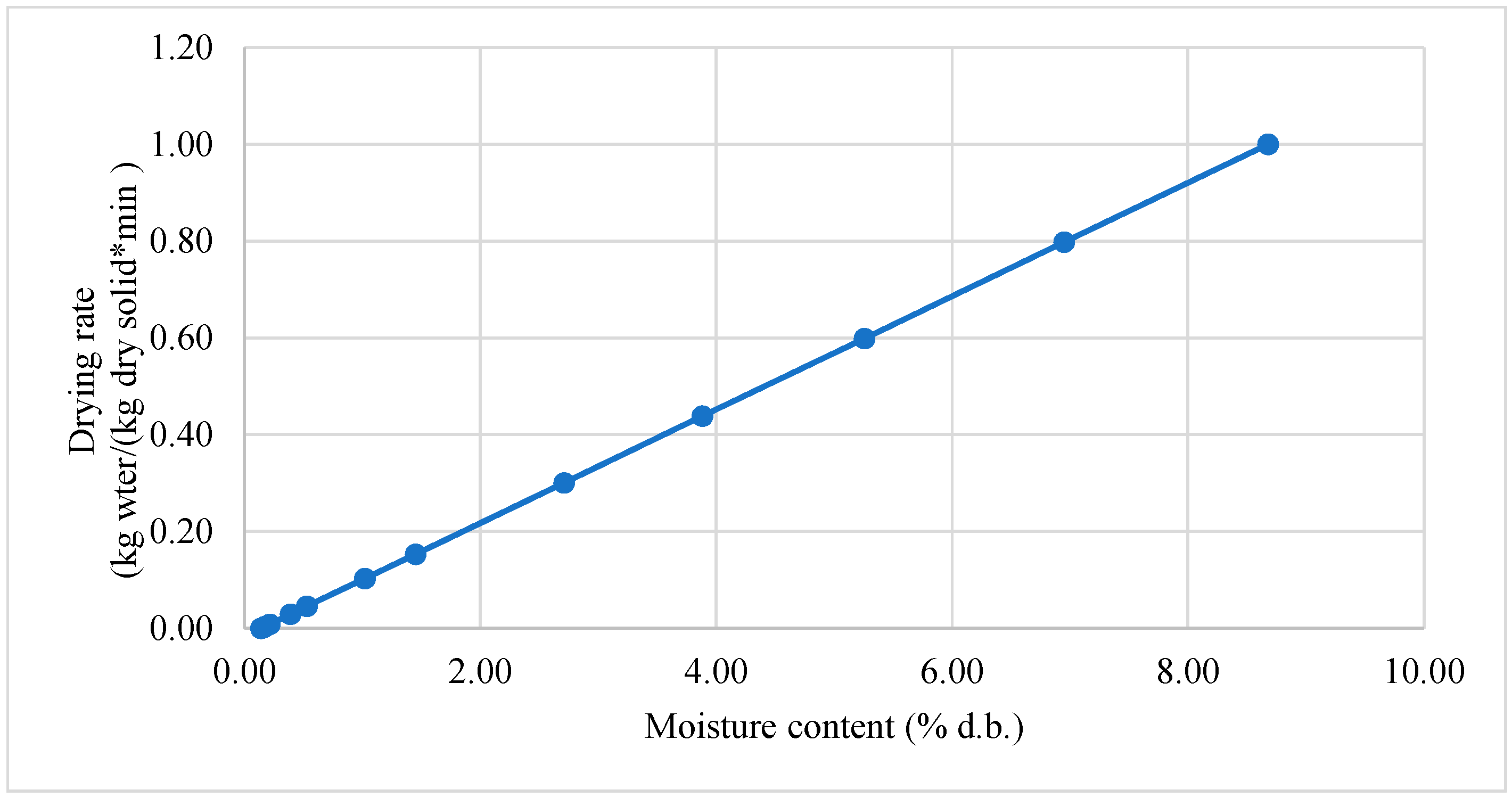
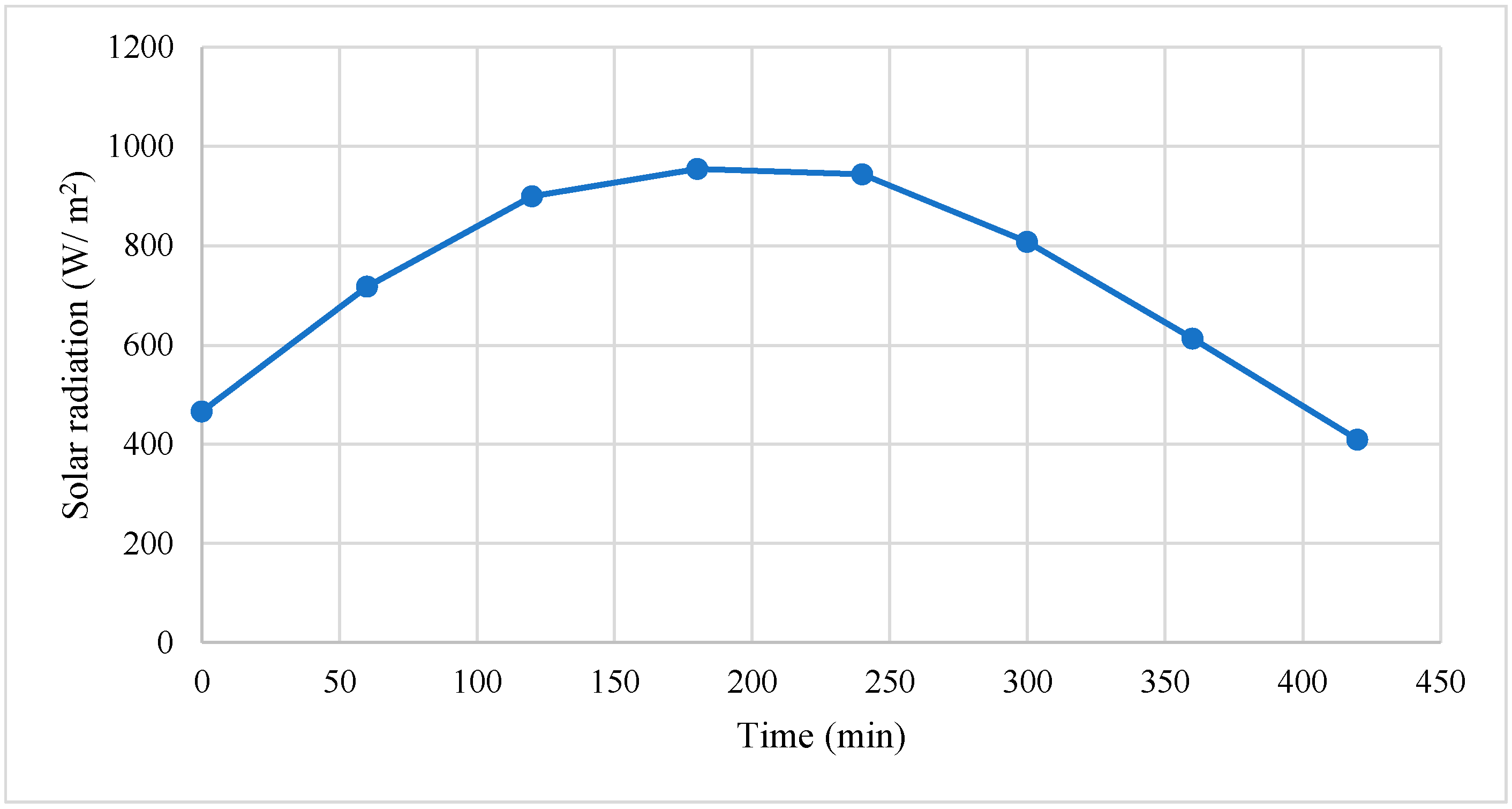
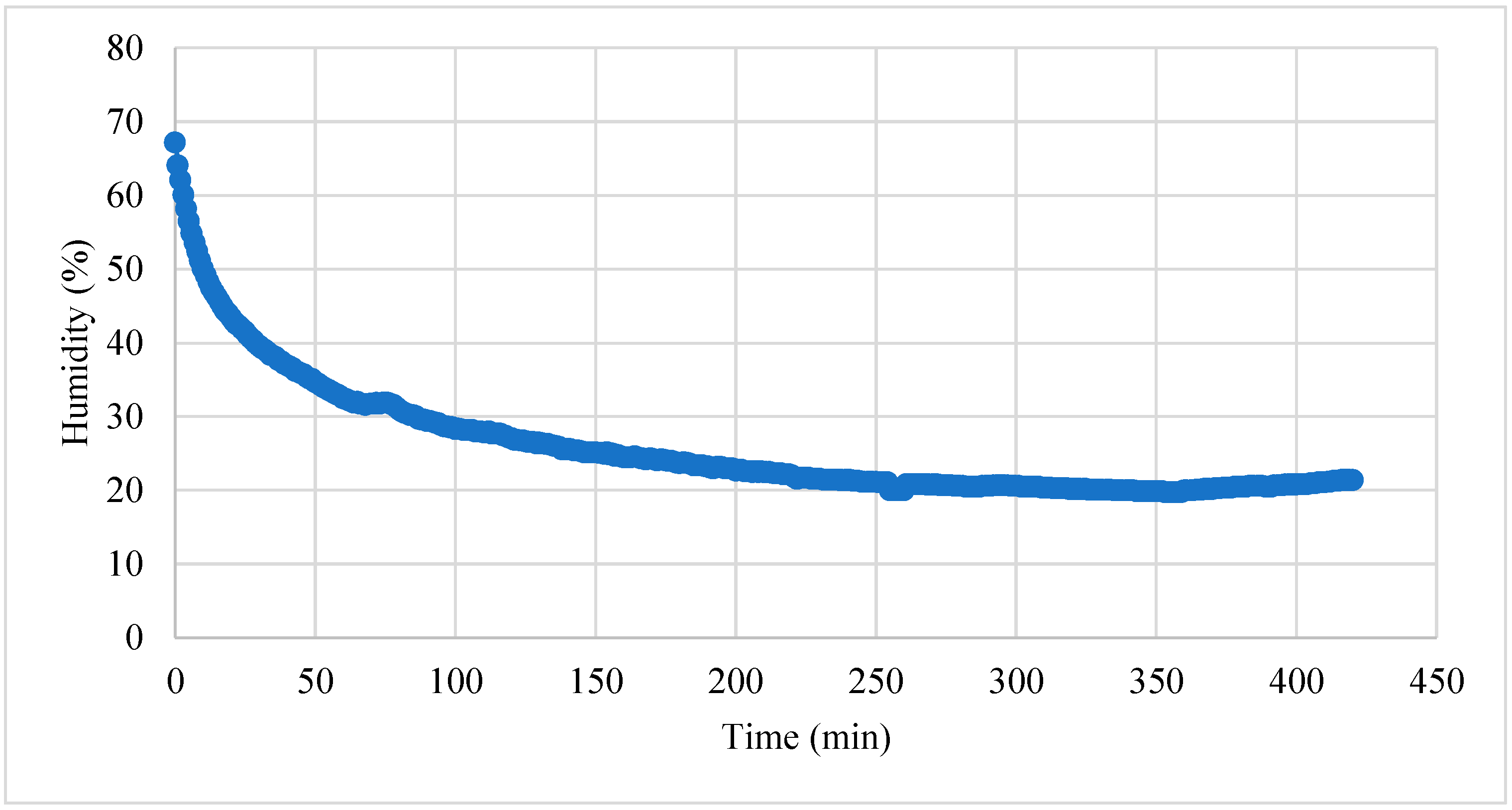
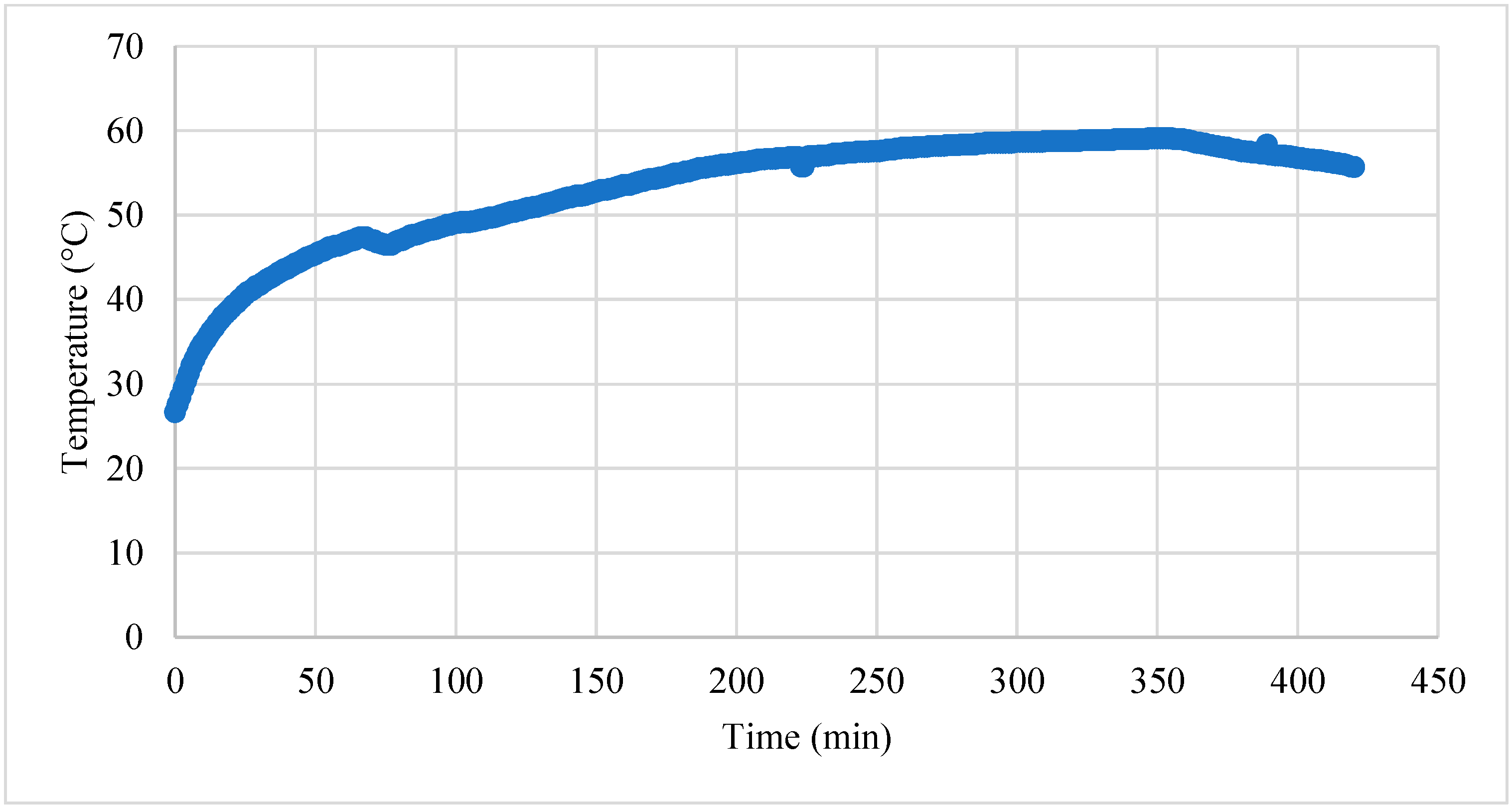

| Drying Methods | L* | a* | b* | ΔE |
|---|---|---|---|---|
| Fresh | 63.81 ± 0.85 c | 1.14 ± 0.27 a | 27.65 ± 0.56 c | 0.00 a |
| Hot air dryer | 37.94 ± 0.27 b | 3.01 ± 0.29 c | 25.86 ± 0.55 b | 26.00 ± 0.23 b |
| Solar greenhouse dryer | 34.50 ± 0.21 a | 2.56 ± 0.32 b | 18.88 ± 0.52 a | 30.63 ± 0.74 c |
| Color | Sweetness | Sourness | Crispness | Overall Quality |
|---|---|---|---|---|
| 7.72 ± 1.04 | 7.55 ± 1.13 | 7.37 ± 1.19 | 7.89 ± 0.83 | 7.89 ± 0.83 |
| No. | Item | Value | Units | |
|---|---|---|---|---|
| Hot Air Dryer | Greenhouse Solar Dryer | |||
| 1 | Capital cost of dryer | 6452 | 12,903 | USD |
| 2 | Life span of dryer | 15 | 15 | Years |
| 3 | Capacity of dryer | 48 | 96 | Kg/batch |
| 4 | Price of fresh mango | 1.61 | 1.61 | USD/kg |
| 5 | Price of dried mango | 7.74 | 7.74 | USD/kg |
| 6 | Salvage value | 10% of capital cost | 10% of capital cost | USD |
| 7 | Maintenance cost | 10% of capital cost | 1% of capital cost | USD |
| 8 | Operational labor cost | 12.90 | 6.45 | USD/batch |
| 9 | Electricity cost | 3.68 | - | USD/batch |
| 10 | Packaging cost | 0.06 | 0.06 | USD/kg |
| 11 | Interest rate | 4.875 | 4.875 | %/year |
| Items | Hot Air Dryer | Greenhouse Solar Dryer | Unit |
|---|---|---|---|
| NPV | 151,417 | 190,050 | USD |
| IRR | 233 | 150 | % |
| PBP BCR | 0.43 24.47 | 0.67 15.73 | Years - |
| Year | Cash Flow in USD | Incremental Cash Flow (GH-HA) | |
|---|---|---|---|
| Hot Air Dryer * | Greenhouse Solar Dryer ** | ||
| 0 | −6452 | −12,903 | −6451 |
| 1–15 | 15,051 | 19,328 | 4277 |
| 15 | 645 | 1290 | 645 |
| Incremental i * (ROR) | 66% | ||
| Year | Cash Flow in USD | Compound Interest Factor | Present Value (PV, USD) | ||
|---|---|---|---|---|---|
| HA | GH | GH+HA | (P/A, 4.875%, 15) | ||
| 0 | −6452 | −12,903 | −19,355 | - | −19,355 |
| 1–15 | 11,205 | 22,999 | 34,204 | 10.4679 | 358,044 |
| NPV | 338,689 | ||||
| Color | Sweetness | Sourness | Crispness | Overall Quality |
|---|---|---|---|---|
| 8.28 ± 0.97 | 8.05 ± 1.38 | 8.00 ± 1.21 | 8.04 ± 1.03 | 8.02 ± 0.89 |
| Drying Method | DPPH (mgTrolox/100 g db) | %Radical Scavenging | FRAP Value (μmoL/100 g db) | Total Phenolic (mg GAE/100 g db) |
|---|---|---|---|---|
| Fresh | 72.28 ± 2.64 b | 39.26 ± 1.48 b | 40.62 ± 0.11 b | 34.41 ± 4.91 b |
| HA | 62.98 ± 1.09 a | 34.19 ± 0.61 a | 29.07 ± 2.32 a | 20.85 ± 3.18 a |
| GH+HA | 64.65 ± 0.71 a | 37.64 ± 0.43 b | 30.23 ± 2.31 a | 29.55 ± 4.59 b |
Publisher’s Note: MDPI stays neutral with regard to jurisdictional claims in published maps and institutional affiliations. |
© 2022 by the authors. Licensee MDPI, Basel, Switzerland. This article is an open access article distributed under the terms and conditions of the Creative Commons Attribution (CC BY) license (https://creativecommons.org/licenses/by/4.0/).
Share and Cite
Kingphadung, K.; Kurdkaew, P.; Siriwongwilaichat, P.; Kwonpongsagoon, S. Comparison of Performance and Economic Efficiency for Greenhouse Solar versus Hot Air Drying: A Case of Crispy Mango Production. Processes 2022, 10, 311. https://doi.org/10.3390/pr10020311
Kingphadung K, Kurdkaew P, Siriwongwilaichat P, Kwonpongsagoon S. Comparison of Performance and Economic Efficiency for Greenhouse Solar versus Hot Air Drying: A Case of Crispy Mango Production. Processes. 2022; 10(2):311. https://doi.org/10.3390/pr10020311
Chicago/Turabian StyleKingphadung, Kanokwan, Patsanan Kurdkaew, Prasong Siriwongwilaichat, and Suphaphat Kwonpongsagoon. 2022. "Comparison of Performance and Economic Efficiency for Greenhouse Solar versus Hot Air Drying: A Case of Crispy Mango Production" Processes 10, no. 2: 311. https://doi.org/10.3390/pr10020311
APA StyleKingphadung, K., Kurdkaew, P., Siriwongwilaichat, P., & Kwonpongsagoon, S. (2022). Comparison of Performance and Economic Efficiency for Greenhouse Solar versus Hot Air Drying: A Case of Crispy Mango Production. Processes, 10(2), 311. https://doi.org/10.3390/pr10020311






